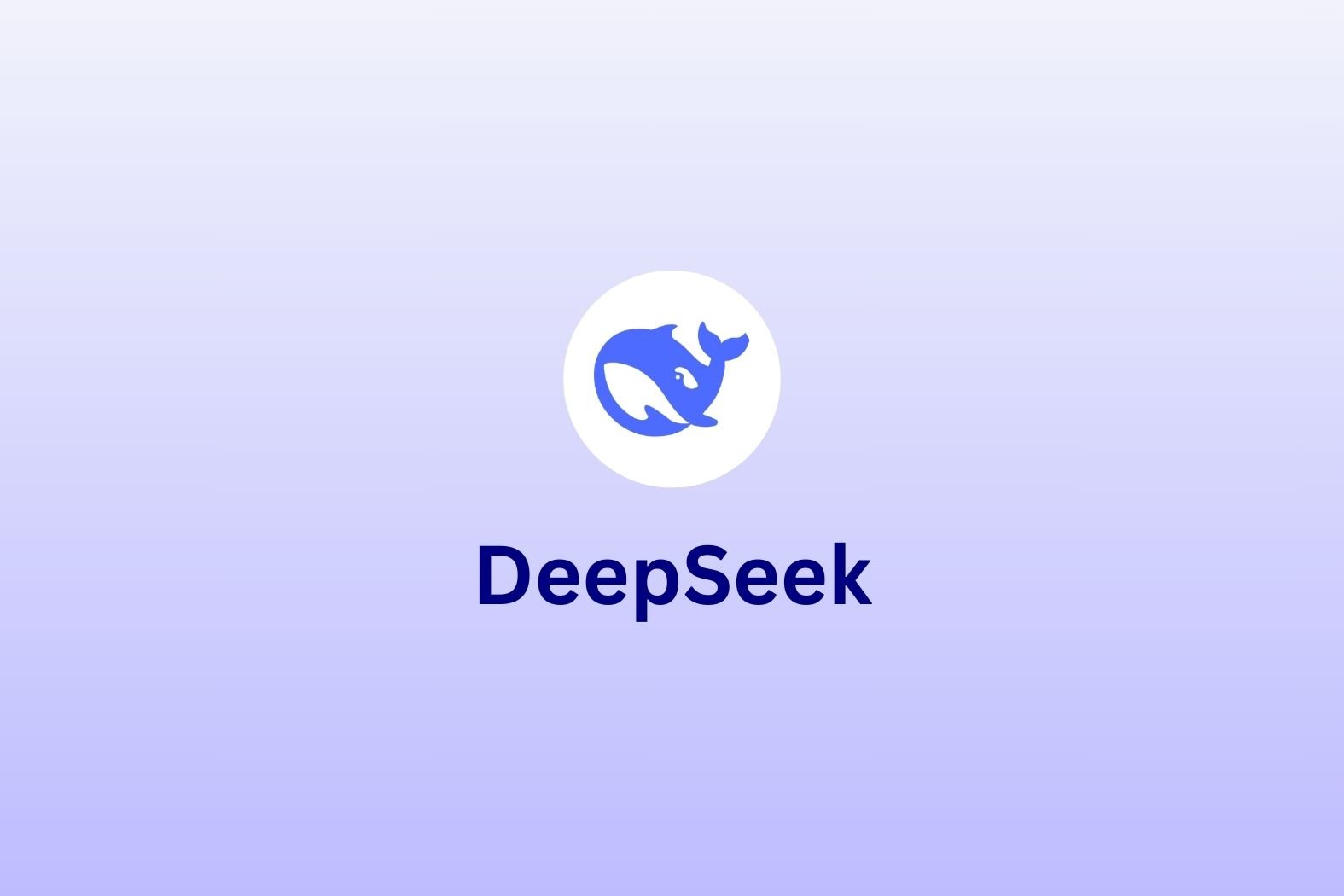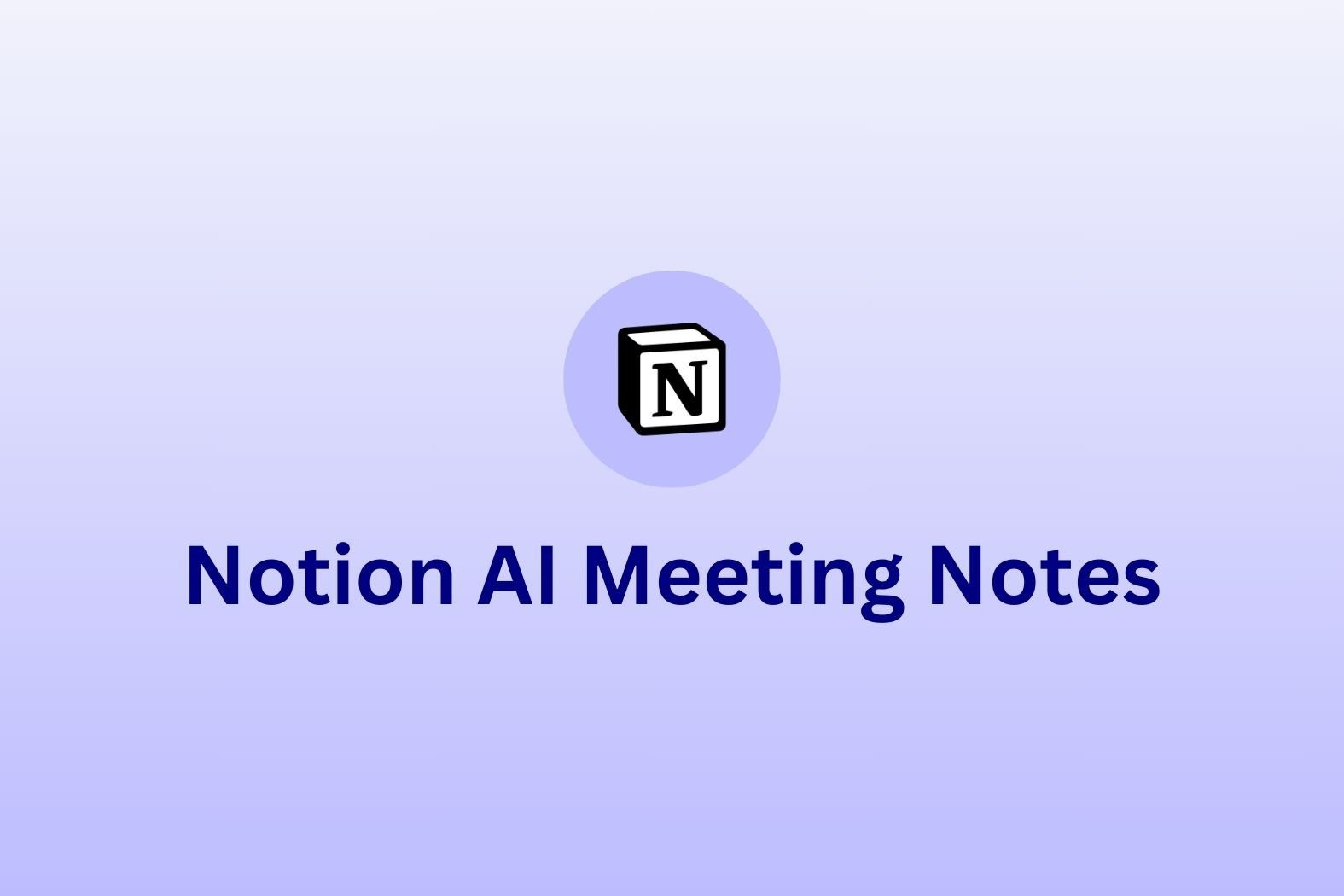What is Deepseek, and why should you care? More importantly, can it replace ChatGPT, and does it provide meeting notes and summaries?
We’ll dive into all this and more, including features, pricing, and security. If you’ve been hearing about Deepseek, a.k.a the Chinese open source ChatGPT, but don’t know whether it’s for you, you will soon.
TL;DR: What You Need to Know About DeepSeek (2025)
DeepSeek is a new AI language model built by the Chinese firm High-Flyer, aiming to challenge industry leaders like ChatGPT and Claude with its cost-efficient, high-performance design. Using a Mixture of Experts (MoE) architecture, DeepSeek activates only the parts of its model needed for each task, making it faster and more resource-efficient.
With claims of outperforming GPT-5 and Claude Sonnet 4.5 in industry benchmarks, it’s gaining attention for its precision, affordability, and potential to democratize access to powerful AI.
However, DeepSeek’s Chinese origins and opaque data policies have sparked privacy and security concerns, especially for businesses operating under strict data compliance laws. While it shows promise for developers and technical users, its limited fine-tuning options, and uncertain infrastructure reliability may limit broader adoption for now.
Best for: Developers, researchers, and data-driven teams looking for an efficient and technically precise AI alternative to U.S.-based models.
Avoid if: You handle sensitive or regulated data, particularly in Western countries.
Verdict: DeepSeek is an impressive newcomer and a potential disruptor in the AI race, but it’s best approached cautiously until its security, transparency, and long-term reliability are more fully verified.
What Actually Is DeepSeek?

DeepSeek is an advanced AI language model designed to rival tools like OpenAI’s ChatGPT and Anthropic’s Claude. Built with a focus on efficiency, adaptability, and cost-effectiveness, DeepSeek has quickly gained attention for its disruptive potential in AI-powered business, research, and personal productivity.
DeepSeek made headlines upon its launch, disrupting financial markets and raising eyebrows with its claimed development cost of just $6 million. If true, that’s 98.89% less than the $540 million reportedly spent by OpenAI in 2022 alone. This would indicate a major shift in AI development costs, making powerful AI models more accessible to smaller companies and research institutions.
However, some experts have questioned whether DeepSeek’s reported cost is accurate, suggesting that the real investment behind its development may be significantly higher when accounting for computing resources, talent, and infrastructure. Regardless of the exact figure, the launch of DeepSeek signals a growing challenge to the dominance of AI giants, proving that new players can emerge with competitive models at potentially lower costs.
Why Is DeepSeek So Popular?
DeepSeek is gaining attention for several reasons. First, it’s completely free to use with no usage limits (unlike ChatGPT), and its weights are also open source and free to use, though its full training data and backend stack remain proprietary. This means anyone can view, copy, download, and modify the model weights that DeepSeek has released publicly. You can download the trained model, run it locally, fine-tune it, or build your own variant, but you can’t see the original training code, datasets, or pipeline used to create it
The AI landscape is changing rapidly, and businesses are looking for alternatives beyond OpenAI and Google, with many looking at moving away from US-based firms completely. DeepSeek’s development suggests that companies want more choices in AI technology, particularly models that offer competitive performance with greater transparency and flexibility.

What’s So Controversial About DeepSeek?
Concerns over AI security and ethical use have sparked interest in users, particularly those in federal positions in the U.S.A and parts of Europe. For instance, DeepSeek is open about its data being stored in centralized Chinese servers. This is a BIG no no for US government workers. In fact, they dislike this so much they banned it for government officials. This ban would also cover Russian, Iranian, or North Korean AI models.
The reason for such a ban?
“We are in a new Cold War—and AI is the strategic technology at the center. The CCP doesn’t innovate—it steals, scales, and subverts. From IP theft and chip smuggling to embedding AI in surveillance and military platforms, the Chinese Communist Party is racing to weaponize this technology. We must draw a clear line: US government systems cannot be powered by tools built to serve authoritarian interests."
John Moolenaar, American Congressman
Essentially, the U.S.A, being the noble, heroic protagonist of the world, fears other countries’ AI because they don’t trust them. But we, the people, have absolutely nothing to fear from OpenAI, Anthropic, or any Western big tech company for that matter. We’re the good guys, remember!
Despite my on-the-nose sarcasm, this is genuinely what American politicians believe (maybe not the good guys part). They think Chinese AI can be used to spy on them. And they’re probably not wrong. Similarly, China has banned OpenAI’s ChatGPT, so it’s tit for tat. They’re both playing the same game, which means it’s very likely that governments have backdoor access to your LLM of choice, regardless of which one you choose. They just don’t tell you about it. Welcome to the post-privacy world.
As things stand, this Chinese-stored data is a big red flag for many Western enterprises. If DeepSeek introduces new safeguards for privacy and security, it could appeal to users who are wary of potential data risks associated with mainstream AI platforms.
DeepSeek vs. ChatGPT: Which One Is Better?
DeepSeek and ChatGPT are both AI-driven models designed for handling language-based tasks, but they are built with different priorities in mind. While ChatGPT is widely recognized for its conversational abilities, DeepSeek has been positioned as an alternative that focuses on structured responses and accuracy in technical fields.
It goes deeper than that however. DeepSeek is open source, allowing absolutely anyone to run their own local version or rebrand it as they wish. It’s also free without usage limits. Despite OpenAI being called “open”, ChatGPT is not open source, not free to use, and does come with a bunch of usage restrictions.
Here’s a quick breakdown of how they compare
Quick Comparison: DeepSeek V3 vs GPT-5 (2025)
| Feature | DeepSeek V3 | GPT-5 (ChatGPT) |
|---|---|---|
| Architecture / Parameters | Mixture of Experts model with ~671B total parameters (≈37B active per token) | Dense Transformer architecture (exact parameter count undisclosed) |
| Context Window | Up to ~128K tokens | Up to ~400K tokens (in premium tiers) |
| Multimodal Capabilities | Primarily text-based; limited image or voice integration | Fully multimodal — supports text, image, and voice |
| Open Source Status | Open-weight (model weights and checkpoints available) | Closed-source (no public weights or code) |
| Pricing | Free for local use; API from ~$0.028 per 1M tokens (input, cache hit) | Input ~$1.25 per 1M tokens; output ~$10 per 1M tokens |
| API Access | Public API and self-hosting options available | Enterprise-level API through OpenAI and Microsoft |
| Fine-Tuning | Available for custom local deployments | Available via OpenAI’s platform only |
| Data Privacy | Depends on deployment; fully private if self-hosted | Managed by OpenAI (SOC 2, GDPR-compliant) |
| Speed | Extremely efficient (~50 tokens/sec reported) | Similar real-time generation (~45–50 tokens/sec) |
| Key Strengths | Cost-effective, flexible, customizable, strong in logic and code reasoning | Broad multimodal intelligence, creative fluency, enterprise reliability |
| Key Limitations | Limited multimodal support, fewer integrations, some privacy concerns | Closed ecosystem, higher cost, limited user control |
What Are the Similarities Between ChatGPT and DeepSeek?
Both models generate text-based responses and can assist with a variety of tasks, from answering questions to drafting content. They are widely used in business, research, and creative fields, helping users streamline workflows and generate ideas.
During popular tests, both OpenAI and DeepSeek models perform similarly across a variety of categories. For instance, OpenAI’s o1 model performs almost identically to DeepSeek’s R1 model in the following tests: AIME 2024, Codeforces, MATH-500, MMLU, and SWE-bench Verified. In fact, according to the graph below, the only one that was more than 1 point difference between them was GPQA Diamond where OpenAI came out on top with 75.7 compared to DeepSeek’s 71.5.
While I couldn’t find a direct head-to-head comparison for the most recent models (GPT-5 and DeepSeek V3.1), here was how they fared against each other earlier this year.

What Are the Key Differences Between ChatGPT and DeepSeek?
While there are clearly plenty of similarities, performance-wise, between ChatGPT and DeepSeek, what about the differences?
According to Wadi Zaatour’s personal tests, DeepSeek is far superior when it comes to coding. He sums it up as follows: “Spoiler: DeepSeek’s focus on code quality, TypeScript mastery, and test coverage makes it the frontend ally you’ve been craving.”
He also discusses coding benchmark results, saying, “In 50 TypeScript React challenges (e.g., generics in hooks), DeepSeek scored 94% accuracy; ChatGPT hit 82%. For complex types (e.g., discriminated unions), DeepSeek was 20% more reliable.”
However, it’s important to remember that DeepSeek only really works with text and code. Meanwhile, ChatGPT can read images as well as create them! This gives it an entirely unique edge that DeepSeek simply doesn’t compete with at all (yet).
For further comparisons, check out Tom’s Guide where he puts both tools through the exact same prompts to compare the outputs. After nine challenges, DeepSeek walks away with a surprising 7-2 victory, notably winning in logic, step-by-step math, project planning, budget coaching, and even social media writing. In short, it seems to understand prompts better even if they’re not explained in-depth.
Here are some more differences between ChatGPT and DeepSeek:
- Handling Complex Problems: As mentioned earlier, DeepSeek is reported to perform better in structured reasoning tasks, with a 91.6% score on the DROP benchmark. This suggests it may be stronger when responding to multi-step logic-based queries. ChatGPT, by comparison, may not always maintain accuracy in complex problem-solving.
- Technical Focus: Some claim that DeepSeek is more reliable for coding, math, and structured data processing, making it better suited for tasks that require precision. ChatGPT, while still capable, sometimes provides responses that need further validation.
- Processing Approach: Where DeepSeek uses a MoE model, activating only the necessary parts of its system for each request, this design reportedly allows it to generate more targeted answers. ChatGPT applies a broader processing method that can lead to more general responses.
- Reliability of Information: Some sources suggest that DeepSeek is less likely to generate misleading or incorrect information. ChatGPT, while capable of engaging discussions, occasionally presents confident but inaccurate responses, particularly in niche technical areas.
Where ChatGPT May Fall Short Compared to DeepSeek
Several reports highlight some of ChatGPT’s weaknesses in technical applications:
According to Forbes, ChatGPT has been known to generate incorrect or misleading responses, sometimes filling in gaps with plausible but incorrect details.
DeepSeek may be more suitable for developers, researchers, and those working with structured data, as it is claimed to provide clearer and more reliable outputs in those areas. For professionals who rely on AI for more interpersonal work, brainstorming, and customer interactions, ChatGPT remains a strong choice due to its conversational abilities and broad knowledge base.
Of course, there’s also clearly the fact that DeepSeek is open source and free-to-use which trumps ChatGPT from multiple angles in one fell swoop.
Who Created DeepSeek and What Is Its Purpose?
DeepSeek was founded in 2023 by Liang Wenfeng, a former math prodigy and hedge fund manager. Based in Hangzhou, Zhejiang province, the company operates as a subsidiary of High-Flyer, a hedge fund co-founded by Liang.
Liang’s vision for DeepSeek was to develop advanced AI models that could rival those of leading Western companies, but at a fraction of the cost. This ambition was driven by a desire to democratize AI technology, making it more accessible and efficient. By leveraging innovative techniques and optimizing available resources, DeepSeek aimed to overcome the limitations imposed by international trade restrictions and the high costs typically associated with AI development.
From what we have seen in the media, DeepSeek’s primary objective is to create open-source large language models that deliver high performance without the need for extensive computational resources. This approach addresses several challenges in the AI industry, including the significant financial and environmental costs of training large models, and the barriers to entry for smaller organizations lacking substantial funding. By focusing on efficiency and accessibility, DeepSeek seeks to broaden the adoption of AI technologies across various sectors.
Comparisons can be drawn with decentralized blockchain AI technologies like the Artificial Superintelligence Alliance, however, their methods differ and their results speak for themselves. Where DeepSeek is downloadable and usable right now, it’s limited to an LLM. ASI intends to be a much greater ecosystem, but it currently has little to show for it in terms of actual adoption and userbase.
How Does DeepSeek Work?
DeepSeek is built using a cutting-edge technique called the Mixture of Experts (MoE), which makes it different from many other AI models like GPT-5 or Llama 3. Google’s own Switch Transformer (2021) pioneered MoE at scale. DeepSeek’s architecture builds on that lineage but optimises routing far more aggressively.
This means that instead of activating all parts of the model for every question or task, DeepSeek only uses the specific sections of its brain that are needed for the job. This helps it work faster and more efficiently while still providing highly accurate answers. In the simplest of forms, it’s like having a team of specialists, where only the right expert steps in to solve a problem.
DeepSeek V3.1, the latest version as of November 2025, uses 37 billion active parameters (like decision-making parts) out of a massive 671 billion total parameters, making it potentially one of the most advanced models out there. This design allows it to perform complex tasks without wasting unnecessary resources.
To train DeepSeek, its creators appear to have used a huge amount of data from different areas, such as language, coding, and math. This wide-ranging training helps it understand and respond to all kinds of queries. For example, in tests like DROP (which measures how well it handles tricky reasoning questions), DeepSeek scored an impressive 91.6%, the highest out of all AI models, showing it’s highly capable at understanding and answering tough questions. Claude 3.5 Sonnet scored 87.1% while GPT-4 turbo scored 86%. Some competitors, like Grok, don’t have scores listed for DROP.
By using smart technology and focusing on efficiency, DeepSeek has the potential to become a powerful tool for businesses, researchers, and individuals who need reliable and quick AI assistance across many fields. It’s designed to handle real-world challenges with precision and speed, making it a standout in the AI space.
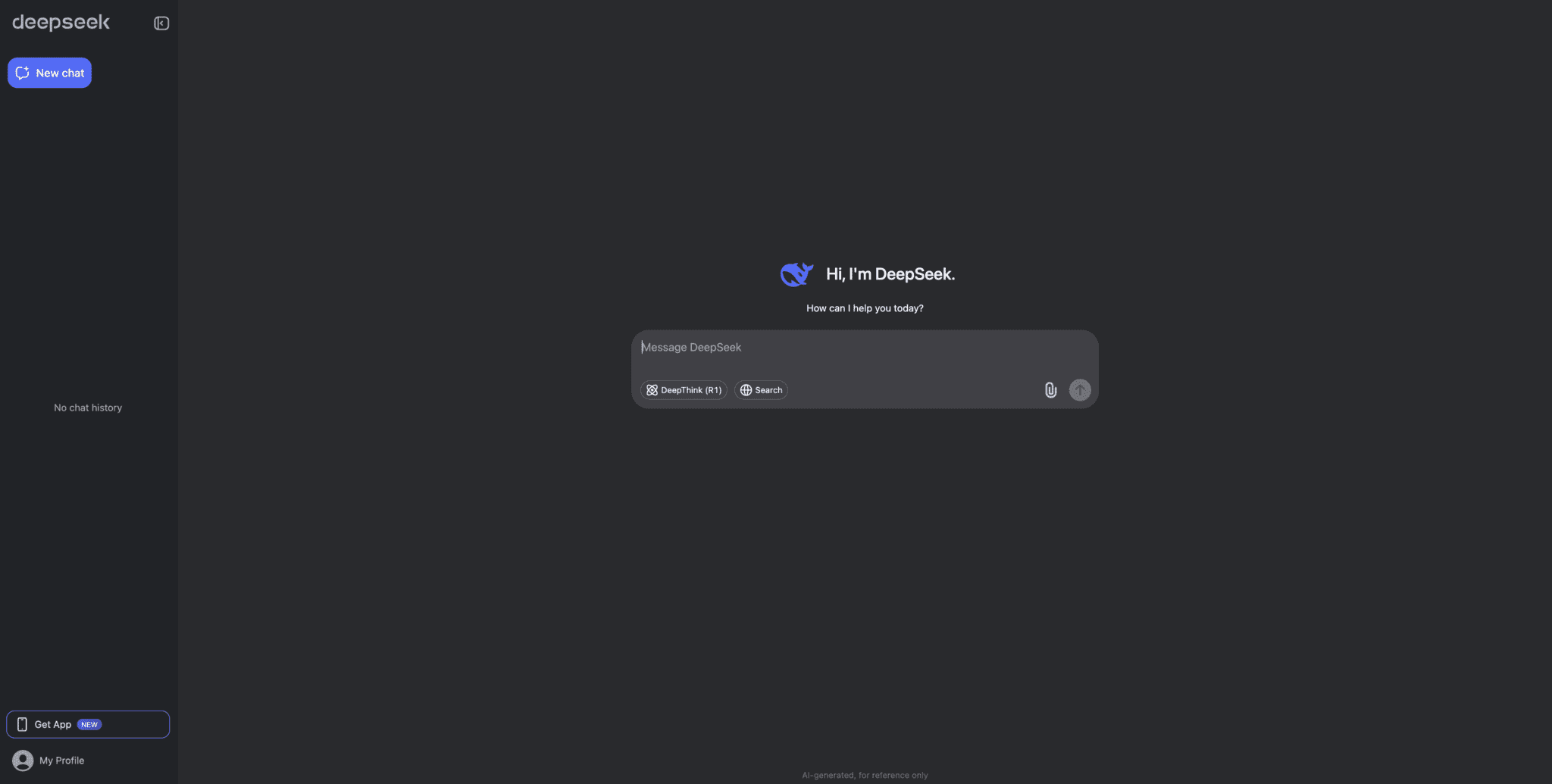
What Are the Key Features of DeepSeek?
DeepSeek has been positioned as a high-performance AI model designed to handle a wide range of tasks, but how does it actually perform in real-world applications? Below, we break down its key features to understand its strengths and potential limitations.
Natural Language Processing (NLP): Can It Handle Complex Queries?
DeepSeek is designed to process complex language tasks, including multi-step reasoning and structured data interpretation. As mentioned earlier, it has performed well on benchmarks like DROP, which test AI models’ ability to handle complex queries.
While this suggests strong capabilities in structured reasoning, it remains to be seen how it performs in real-world conversational interactions compared to ChatGPT, which is widely regarded for its nuanced and natural dialogue.
Multimodal Capabilities: Can It Process Images, Audio, or Video?
Some AI models, such as GPT-5, support multimodal input, allowing users to process images, audio, and even video. At present, DeepSeek itself is primarily text-based, however you can go onto janus-deepseek.com to access their multimodal chatbot who can understand and create images.
In the near future, DeepSeek intends to release a next-gen multimodal AI system that combines text, image, and voice processing. This was due in Q3 2025 but has not been released as of November 2025 as far as I’m aware.
Customization: Can Businesses Fine-Tune DeepSeek for Their Needs?
For AI adoption in business settings, customization is crucial. While OpenAI provides API access to GPT models, allowing some degree of fine-tuning, DeepSeek also uses an API (actually a modified version of OpenAI’s) so it can be used in a similar way. Plus, as DeepSeek is open source, if you’re tech-savvy enough, you can customize the code directly. The downside is it would require users to store their data in China, which may run opposite to what Western governments advise.
Speed & Response Time: How Fast Is It Compared to Competitors?
One of DeepSeek’s selling points is its MoE architecture, which selectively activates parts of the model rather than processing everything at once. This should, in theory, make it faster than fully dense models like ChatGPT. However, some users have reported server issues and slow response times, raising questions about its reliability in high-demand scenarios.
API & Integration: How Easy Is It to Connect with Other Tools?
APIs are critical for businesses looking to integrate AI into their workflows. Like OpenAI and Anthropic , DeepSeek’s API is available to use to anyone. You can find out all the informagtion you need in their API docs.
Developers will need to assess whether it provides the same level of accessibility and documentation as its competitors before considering it for large-scale applications.

What Is DeepSeek Used For?
DeepSeek is designed to handle a variety of tasks across different industries. Whether for business, research, creative projects, or everyday productivity, its capabilities are meant to be used in a number of ways:
Business Applications: Customer Support, Automation, Content Generation
DeepSeek has the potential to be integrated into customer service platforms, helping businesses manage inquiries efficiently. While models like ChatGPT are widely used in chatbot services, DeepSeek’s structured approach could be beneficial for handling precise, technical, or data-driven responses.
Automation is another area where AI models play a crucial role. Businesses can hypothetically use DeepSeek to assist with report generation, financial analysis, or workflow automation, reducing manual effort and improving efficiency. Additionally, content teams could explore DeepSeek for product descriptions, and marketing material, though its effectiveness in creative applications compared to more conversational AI models remains to be seen.
Academic & Research Uses: Data Analysis, Summarization, Language Translation
DeepSeek’s reported strengths in structured reasoning suggest it could be useful for academic research and data analysis. Researchers can use AI to summarize large volumes of information, extract key insights, and assist with literature reviews.
In education, DeepSeek could support language translation for multilingual content, aiding students and professionals who need high-quality translations. If its language processing capabilities match or exceed existing models, it may become a useful tool in academic settings for tasks like summarizing research papers or generating study materials.
Creative Uses: Writing, Coding, Brainstorming Ideas
Creative professionals use AI to enhance productivity, whether for drafting content, brainstorming, or writing code. DeepSeek’s structured processing may make it particularly useful for coding tasks, helping developers debug issues, generate scripts, or optimize algorithms.
For writers, AI can assist in generating outlines, refining content, or exploring alternative phrasing. However, given DeepSeek’s reported technical focus, its suitability for creative writing and storytelling compared to more conversational models like ChatGPT remains uncertain.
Everyday Productivity: Note-Taking, Scheduling, Quick Answers
AI tools are increasingly being used for personal productivity, helping users manage tasks, take notes, and stay organized. DeepSeek could be integrated into digital assistants for quick information retrieval, summarization, or scheduling support.
For individuals who rely on AI to boost efficiency, DeepSeek may offer an alternative for structuring and analyzing information. If its response speed and reliability improve, it could be positioned as a useful tool for everyday tasks, complementing or competing with existing AI-powered productivity tools.
Initial Reactions To DeepSeek
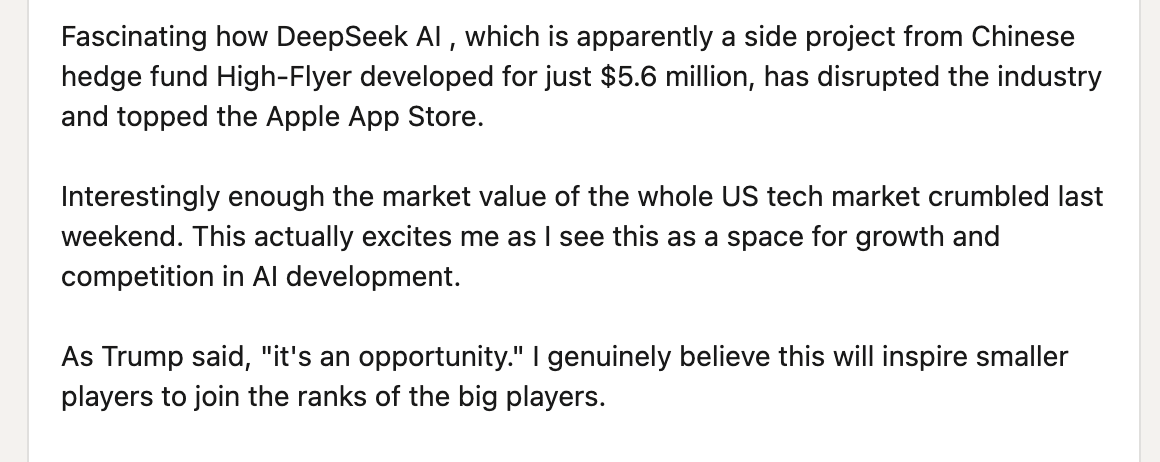
When DeepSeek first launched, it ignited lively discussions across professional networks and social platforms. On one side, there was a wave of excitement, with many hailing it as a long-awaited challenger to established AI leaders like OpenAI and Google.
Industry professionals highlighted its affordability, with claims of a $6 million development cost sparking both intrigue and skepticism. Others were impressed by its technical benchmarks, suggesting it could be a game-changer for structured reasoning and efficiency in AI applications.
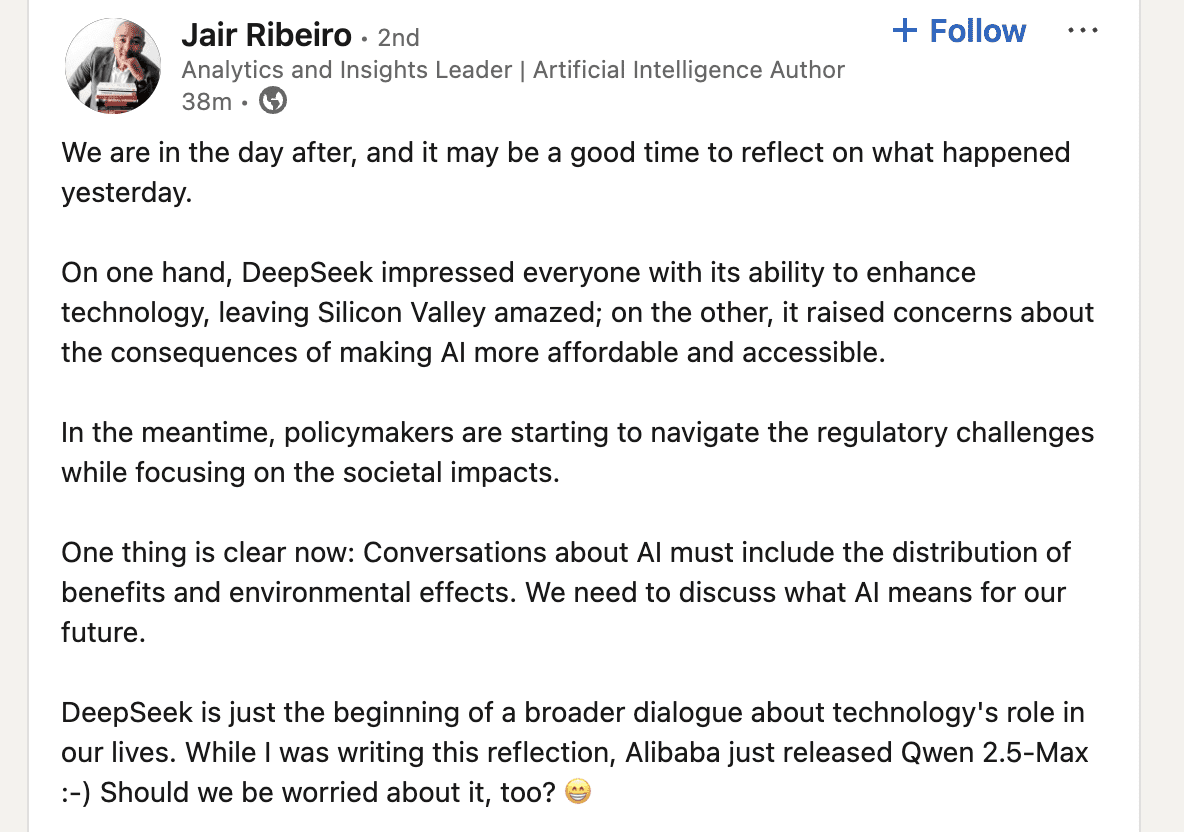
However, concerns emerged about its origins and potential geopolitical implications. The fact that DeepSeek is backed by a Chinese hedge fund has prompted discussions around data governance, privacy, and regulatory compliance. This is particularly for businesses operating in the U.S. and Europe. Some worry that these factors could complicate its adoption, even as it garners interest for its innovative architecture and open-source accessibility.

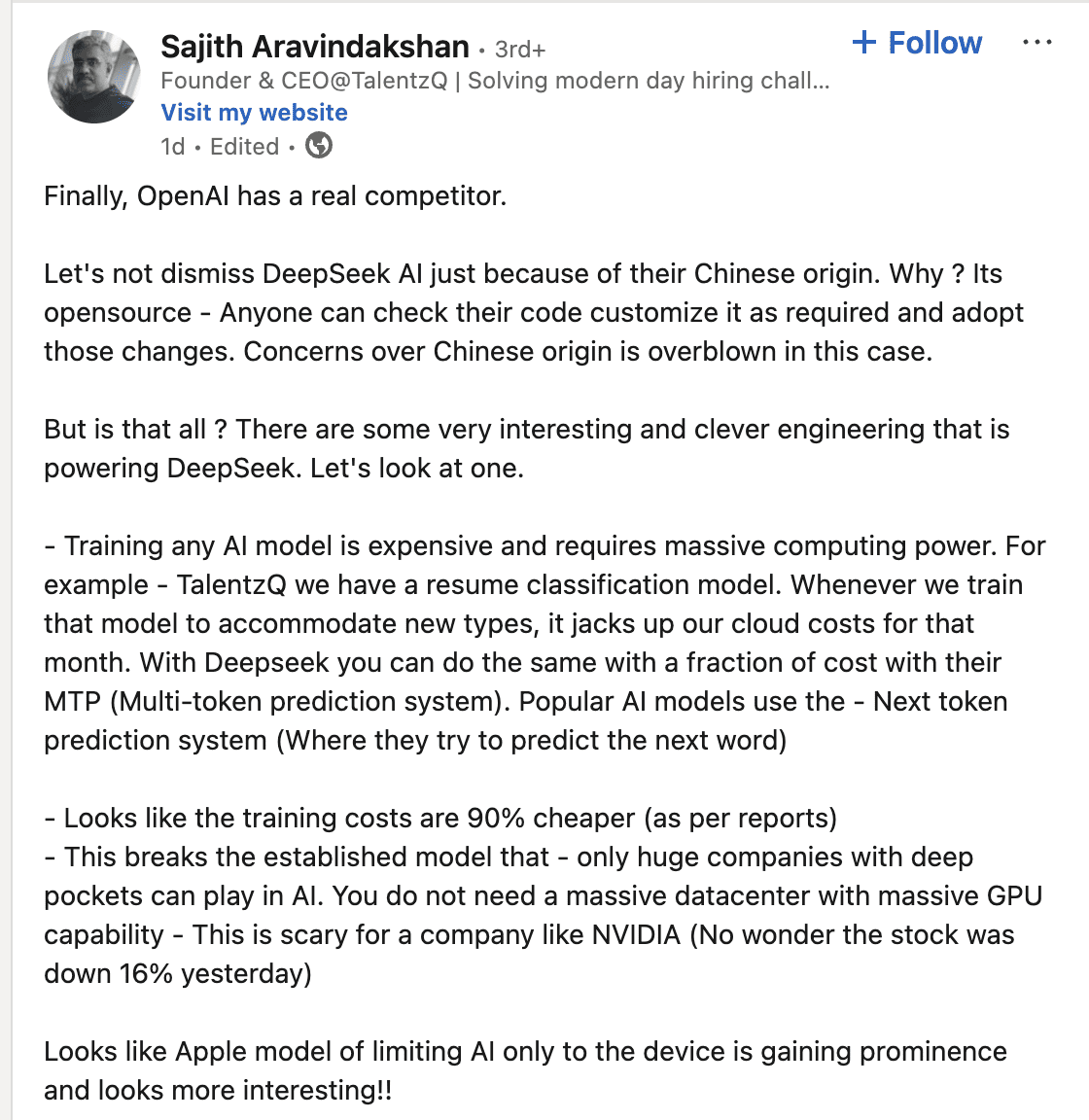

DeepSeek’s debut divided opinion. While many viewed it as a symbol of progress and competition in the AI space, others urged caution, emphasizing the need for thorough testing and transparency before it can be fully embraced as a viable alternative to established AI models.
Since its launch, DeepSeek has been slow to release updates, with another model scheduled for late 2025. While it appeared to take the AI world by storm in its first few weeks, its impact has since tapered off.
Having said that, Mario Nawfal believes Silicon Valley is already running on Chinese AI, regardless of the warnings from governments. He highlights that Airbnb went with Alibaba’s Qwen and that there are rumors of Cursor using DeepSeek behind the scenes. Ironically though, his tweet was likely written by AI.

How Safe Is DeepSeek to Use?
AI tools are powerful but require careful security measures to prevent data misuse. Whether using ChatGPT, Claude, or DeepSeek, businesses should assess where their data is stored, how it’s processed, and whether it meets compliance standards.
DeepSeek, like other AI models, collects and processes user inputs, but its data policies and geographic ties bring additional considerations. While it offers advanced capabilities, it’s important to assess whether it aligns with your security requirements.
How Does DeepSeek Handle User Data?
DeepSeek, according to its privacy policy, collects user interactions, including text inputs, uploaded files, and feedback. Like many AI models, this data is used to improve the system. However, one key difference is that DeepSeek’s servers are located in China, which may impact data access and governance.
However, this is only the case if you are relying on cloud storage. There is another option: use the API to self-host your own DeepSeek model. That way, data storage remains local and you’re in charge of your privacy. It requires more technical know-how and possibly more money to run your own servers, but it’s a smart workaround for those that want it.
Key Considerations for Security and Privacy
- Where is data stored? DeepSeek’s storage location matters because data privacy laws vary by country. Businesses operating in regions with strict data compliance requirements should consider where their information is processed and held. By self-hosting, you can overcome some of these restrictions.
- Who has access to the data? While DeepSeek states that it follows security best practices, Chinese data laws allow government authorities to request access to information stored within the country. This may raise concerns for companies handling confidential or regulated data.
- How long is data retained? The platform does not publicly disclose specific retention policies, which means users don’t have clear insight into how long their data is stored or when it is deleted.
- Does DeepSeek store interactions? AI models often retain some interactions to refine their responses, but the extent of DeepSeek’s data storage remains unclear compared to more widely documented AI platforms like OpenAI’s ChatGPT.
- Does it censor certain topics? Reports from media outlets, including The Guardian, indicate that DeepSeek has been observed censoring responses related to politically sensitive topics. While content moderation exists in all AI models, users should be aware that DeepSeek may provide restricted answers depending on the subject. Though it’s worth mentioning that this isn’t an issue that DeepSeek faces alone. Pick your poison.
- What does this mean for international businesses? For companies operating in regions with complex international relations, the geopolitical aspect of AI usage is worth considering. Some organizations may face compliance or security challenges if AI tools are subject to external oversight. TechRadar highlights that even OpenAI CEO Sam Altman has acknowledged DeepSeek’s advancements but suggests future AI competition may be influenced by broader security concerns.
For users in certain industries, such as finance, legal, or healthcare, carefully reviewing DeepSeek’s data policies before adoption is advisable. Being aware of where and how AI processes information helps businesses make informed choices that align with their security and compliance needs.
What Is Janus and Janus-Pro-7B?
On January 27, 2025, DeepSeek announced the release of Janus-Pro-7B , an advanced open-source AI model designed for text-to-image generation. According to DeepSeek’s press communications, Janus-Pro outperforms other leading models like OpenAI’s DALL-E 3 and Stability AI’s Stable Diffusion in benchmark tests.
In August 2025, this was confirmed by third party tests. They found that Janus-Pro-7B’s text-to-image tasks had an 80% overall accuracy rate, compared to DALL-E’s 67%. Janus also set a new benchmark with 99% single-object accuracy.

The launch of Janus-Pro follows DeepSeek’s earlier release of R1, an AI model designed for logical inference and problem-solving. Together, these developments signal DeepSeek’s ambition to compete directly with industry leaders across multiple AI disciplines, from language models to visual generation and reasoning-based AI.
Can DeepSeek Summarize Meetings?
Some of DeepSeek’s competitors, including ChatGPT, allow users to record, summarize, and even take meeting notes during live calls. ChatGPT Record is a great example, though it suffers from a lot of problems compared to specialized tools that were specifically built to take notes.
Can DeepSeek do the same?
Not quite. DeepSeek is capable of summarizing a meeting transcript, if you already have that transcript from another software. For instance, if you have a Google Meet call, you can get Google to generate a transcript for you, upload that to DeepSeek, and then get it to summarize, make notes, highlight action items, and more.
Here’s an example of how it might work:
However, this method is time-consuming and labor-intensive. An even better option is to use a dedicated AI note-taker. A virtual meeting tool, like tl;dv for example, can automatically join your calls, record and transcribe them, take notes, summarize, highlight action items and next steps, and way more. It can provide sales coaching tips to help you close more deals; it offers multi-meeting intelligence so you can uncover patterns across multiple calls at once; and it even lets you schedule recurring reports about specific topics of your choice, so you get updates direct to your inbox.
What Is tl;dv Doing to Ensure AI Security?
tl;dv is committed to ensuring the security and privacy of user data, especially when integrating AI technologies into its platform. Here’s an overview of the measures tl;dv has implemented:
Data Encryption and Compliance
tl;dv employs encryption protocols to protect meeting recordings and transcripts both during transmission and while stored. This approach ensures that data remains confidential and secure from unauthorized access. Additionally, tl;dv adheres to GDPR regulations, underscoring its dedication to data protection and user privacy.
Integration with Anthropic’s Claude
In partnership with Anthropic, tl;dv has integrated Claude, an AI system designed with a focus on safety and privacy. Notably, tl;dv ensures that no customer data is used to train the AI. Mechanisms have been added to keep user data safe and secure during AI processing.
Data Anonymization and Access Control
To further protect user privacy, tl;dv anonymizes data shared with Anthropic. Personal identifiers such as email addresses, company names, and user names are removed before processing. Additionally, access to meeting recordings and transcripts is restricted to authorized personnel only, ensuring that sensitive information remains confidential.
Why tl;dv Chose Claude Over Other AI Models
While some AI models have less transparent security policies, tl;dv integrates Claude, developed by Anthropic, because of its strong privacy safeguards and ethical AI framework. This ensures that user data is handled with security and compliance in mind, offering businesses a more privacy-conscious AI solution.
How to Best Use DeepSeek
DeepSeek is available for users to explore, but how you access it depends on its current release stage and whether you need it for personal or business use.
How to Access DeepSeek
DeepSeek offers free access through its website and mobile apps, allowing users to sign up using a Google account. Developers can also interact with DeepSeek’s open-source API, which follows OpenAI’s API format, making integration easier for those already working with AI tools.
How to Integrate DeepSeek Into Workflows
For developers and businesses, DeepSeek provides an API key through the DeepSeek Open Platform, allowing companies to integrate its capabilities into their applications. Resources, including documentation and community discussions, are available on DeepSeek’s GitHub, where users can find guides for setting up the model.
Considerations Before Using DeepSeek
While DeepSeek presents itself as a competitive AI model, users should be aware of data privacy concerns. As mentioned earlier, DeepSeek’s data storage policies and the location of its servers may impact regulatory compliance, particularly for businesses operating in the U.S. and Europe.
Unlike AI companies based in the U.S. or EU, where data privacy laws like GDPR set clear guidelines, companies using DeepSeek should carefully review how it handles user information. While this is a consideration with any AI model, different regions have different expectations, and businesses should evaluate the risks before integrating DeepSeek into sensitive workflows.
How Good is DeepSeek? Is It Worth It?
DeepSeek is fine to have a play around with, and while it scores better than OpenAI’s GPT-5 on the vast majority of benchmarks and tests, it still appears to struggle with lengthy conversations. As it’s free and open source, it’s definitely worth looking into a little bit more.
The main issue is with data privacy. The Chinese government may be able to access your data. Whether you’re okay with that is up to you and your business.
To recap it all, DeepSeek is an emerging AI model that has generated interest for its efficiency, structured reasoning, and potential lower cost of development compared to competitors like ChatGPT and Claude. It stands out for its Mixture of Experts architecture, which selectively activates different parts of the model for better performance in technical and structured tasks such as coding, data analysis, and problem-solving. However, it remains relatively untested in broader real-world applications, particularly in business integration.
For developers and researchers, DeepSeek may offer a useful alternative for handling complex reasoning and structured data tasks. Businesses looking for AI solutions beyond OpenAI and Google could explore its capabilities, but considerations around security, data privacy, and regulatory differences should be factored into the decision. While DeepSeek has the potential to challenge established AI leaders, its long-term impact and reliability remain to be seen.
The one thing we are certain of? tl;dv’s commitment to security and privacy is clear. Get started today for free.
FAQs About DeepSeek (2025)
What is DeepSeek?
DeepSeek is a large language model (LLM) developed by High-Flyer AI, a Chinese company. It uses a Mixture of Experts (MoE) architecture to selectively activate parts of its neural network, giving it GPT-level intelligence while being far more efficient and cost-effective.
Is DeepSeek open source?
Yes, DeepSeek’s model weights are open and free to use, with checkpoints available on platforms like Hugging Face. However, it’s more accurate to call it open-weight rather than fully open-source: the full training data, pre-training code, and some fine-tuning infrastructure are not publicly released.
Is DeepSeek really free?
Yes, for the most part. You can download and run DeepSeek locally or through third-party platforms without paying licensing fees. However, using DeepSeek through High-Flyer’s official API may incur usage costs depending on scale and integration needs, similar to how open models like Llama 3 can still have hosted paid options.
Is DeepSeek secure and private?
Security is one of the most discussed topics around DeepSeek. Because it’s developed in China, some experts express concerns about data privacy and potential compliance risks, especially for users under strict frameworks like GDPR or SOC 2.
If you self-host DeepSeek, your data stays on your servers, which eliminates most of those risks. But if you use High-Flyer’s hosted API, data handling transparency remains limited compared to Western competitors like OpenAI or Anthropic.
How does DeepSeek compare to ChatGPT (GPT-5)?
DeepSeek’s strengths lie in efficiency, cost, and openness, while GPT-5 leads in multimodality, reasoning depth, and enterprise support.
| Feature | DeepSeek-V3 | GPT-5 (ChatGPT) |
|---|---|---|
| Architecture | Mixture of Experts (671B total, ~37B active) | Dense Transformer |
| Open Source | ✅ Open weights (Hugging Face) | ❌ Closed |
| Cost | ~$6 million training (≈99% less than GPT-4) | $500M–$1B est. |
| Speed | ~50 tokens/sec | ~48 tokens/sec |
| Reasoning | Very strong (math/code) | Stronger overall (especially with tools) |
| Multimodality | ❌ Text only (Janus is separate) | ✅ Text, image, voice |
| Privacy | Depends on self-hosting | Fully managed by OpenAI |
| Use Cases | Devs, researchers, data science | Businesses, creatives, enterprise AI |
Who is DeepSeek best for?
DeepSeek is perfect for developers, researchers, and small AI startups who want to tinker, self-host, or build custom AI workflows without high API costs. It’s also ideal for anyone seeking a transparent, modifiable model they can fine-tune on private data.
What are the downsides of DeepSeek?
-
Limited documentation compared to GPT or Claude
-
No built-in multimodal support (text only)
-
Security transparency concerns (for hosted use)
-
Smaller ecosystem and fewer integrations
-
Early-stage infrastructure (occasional API instability)
Will DeepSeek replace ChatGPT?
Not anytime soon, but it could become a powerful open alternative. GPT-5 still dominates for creative writing, multimodal interaction, and enterprise AI. DeepSeek’s promise lies in democratizing access to advanced AI, doing more with less, and giving developers real control over their tools.
DeepSeek even said in their own roadmap that they are focusing on businesses first and foremost, and personal use only from 2028 onwards.

